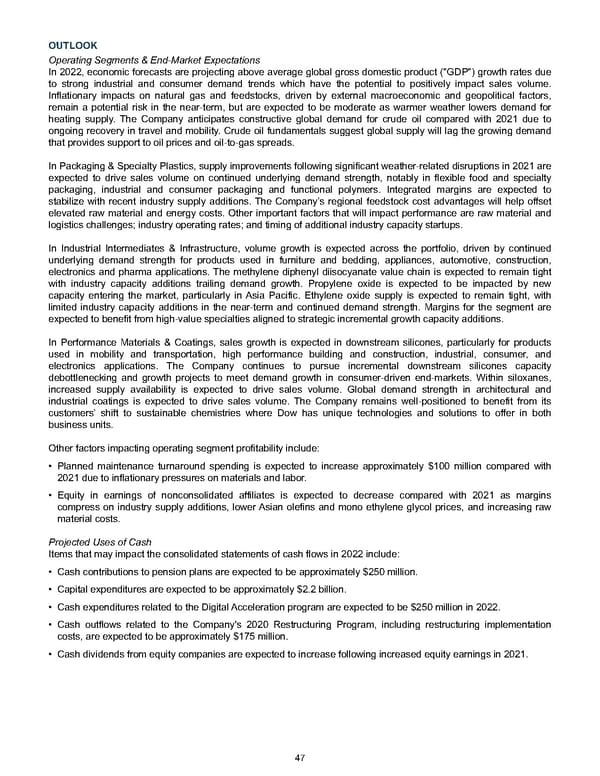OUTLOOK Operating Segments & End-Market Expectations In 2022, economic forecasts are projecting above average global gross domestic product ("GDP") growth rates due to strong industrial and consumer demand trends which have the potential to positively impact sales volume. Inflationary impacts on natural gas and feedstocks, driven by external macroeconomic and geopolitical factors, remain a potential risk in the near-term, but are expected to be moderate as warmer weather lowers demand for heating supply. The Company anticipates constructive global demand for crude oil compared with 2021 due to ongoing recovery in travel and mobility. Crude oil fundamentals suggest global supply will lag the growing demand that provides support to oil prices and oil-to-gas spreads. In Packaging & Specialty Plastics, supply improvements following significant weather-related disruptions in 2021 are expected to drive sales volume on continued underlying demand strength, notably in flexible food and specialty packaging, industrial and consumer packaging and functional polymers. Integrated margins are expected to stabilize with recent industry supply additions. The Company’s regional feedstock cost advantages will help offset elevated raw material and energy costs. Other important factors that will impact performance are raw material and logistics challenges; industry operating rates; and timing of additional industry capacity startups. In Industrial Intermediates & Infrastructure, volume growth is expected across the portfolio, driven by continued underlying demand strength for products used in furniture and bedding, appliances, automotive, construction, electronics and pharma applications. The methylene diphenyl diisocyanate value chain is expected to remain tight with industry capacity additions trailing demand growth. Propylene oxide is expected to be impacted by new capacity entering the market, particularly in Asia Pacific. Ethylene oxide supply is expected to remain tight, with limited industry capacity additions in the near-term and continued demand strength. Margins for the segment are expected to benefit from high-value specialties aligned to strategic incremental growth capacity additions. In Performance Materials & Coatings, sales growth is expected in downstream silicones, particularly for products used in mobility and transportation, high performance building and construction, industrial, consumer, and electronics applications. The Company continues to pursue incremental downstream silicones capacity debottlenecking and growth projects to meet demand growth in consumer-driven end-markets. Within siloxanes, increased supply availability is expected to drive sales volume. Global demand strength in architectural and industrial coatings is expected to drive sales volume. The Company remains well-positioned to benefit from its customers’ shift to sustainable chemistries where Dow has unique technologies and solutions to offer in both business units. Other factors impacting operating segment profitability include: • Planned maintenance turnaround spending is expected to increase approximately $100 million compared with 2021 due to inflationary pressures on materials and labor. • Equity in earnings of nonconsolidated affiliates is expected to decrease compared with 2021 as margins compress on industry supply additions, lower Asian olefins and mono ethylene glycol prices, and increasing raw material costs. Projected Uses of Cash Items that may impact the consolidated statements of cash flows in 2022 include: • Cash contributions to pension plans are expected to be approximately $250 million. • Capital expenditures are expected to be approximately $2.2 billion. • Cash expenditures related to the Digital Acceleration program are expected to be $250 million in 2022. • Cash outflows related to the Company's 2020 Restructuring Program, including restructuring implementation costs, are expected to be approximately $175 million. • Cash dividends from equity companies are expected to increase following increased equity earnings in 2021. 47
 Annual Report Page 56 Page 58
Annual Report Page 56 Page 58